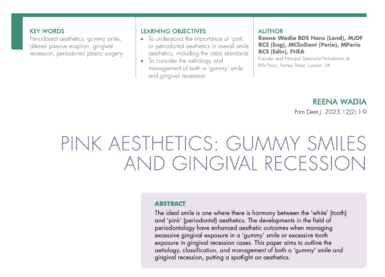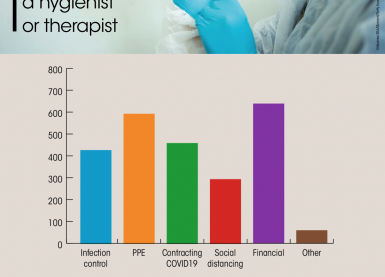May 11, 2021

NEW PATIENT ASSESSMENT
CO & HPC:
Perio – Bleeding/Loose teeth/Halitosis/Bad taste/Difficulty eating/Sensitivity/Pain/Swelling/Gum boils/Aesthetics/Anything else
MH: Checked- see medical notes
FH: Any family history of Perio?
SH:
Smoking – /day x years (what substance is smoked?) Considering cessation?
Alcohol – units/week (or number of glasses of wine/pints of beer etc. a week)
Occupation –
Stress levels –
DH:
Toothbrushing- Brushes /day with a F- toothpaste for mins (manual/electric)
Interdental cleaning-
Mouthwash-
Diet- sugar, acid
Parafunctional or Other habits-
Dental anxieties-
EO:
TMJ & muscles of mastication – NAD
Lips – NAD
Symmetry – NAD
Scars – NAD
IO-
Soft tissues:
Labial mucosa – NAD
Buccal mucosa – NAD
FOM – NAD
Tongue – NAD
Hard & soft palate- NAD
Oropharyngeal region- NAD
Gingivae –
BPE- Completed?
Oral hygiene- good/fair/poor, plaque-, calculus-
Periodontal examination –
6PPC completed –
IO- Hard tissue:
TIQ
Base chart updated?
Tooth wear?
Other findings?
Special investigations:
Radiographs: Are these available from the referring dentist? Required?
Sensibility tests:
Definitive diagnosis(es):
Key risk factors: Suboptimal oral hygiene? Smoking? Medical condition? Stress?
Prognosis:
Discussed diagnosis (type of condition and severity) and aetiology at length with patient and ensured they understood. Discussed the treatment options including benefits, risks, time and cost – understood by patient and all questions answered. Benefits discussed included improving the lifespan of the teeth by reducing periodontal pockets and preventing progression of the condition. Discussed the risk of post-treatment sensitivity of the teeth, explained this usually lasts for a few weeks but in rare cases may remain indefinitely if does not respond to treatment for sensitivity. Emphasised that during treatment the gums may shrink back due to recession and so the teeth can look longer with gaps in between teeth/’black triangles’. Other side effects of treatment include pain, soreness, bleeding, swelling, bruising. Explained that during the cleaning process, there is always a chance of damaging/loosening/decementing any restorations/veneers/crowns/bridges. If this happens, it is usually because they were already loose or attached to unhealthy tooth. On most occasions a temporary filling can be placed or the veener/crown/bridge recemented but this is not guaranteed and it is a risk during the procedure. We cannot cover any costs for new fillings/veneers/crowns/bridges. Patient understood.
Explained initial course of root surface debridement and tailored oral hygiene instruction would be required. Importance of good patient compliance to appointments and an optimal level of oral hygiene emphasised. Following a course of non-surgical debridement, the condition would need to be reassessed by carrying out a 6PPC (full mouth measurements) and thereafter further treatment planned. Explained may need more than one course of non-surgical debridement. Explained referral to specialist might become appropriate. Once stable, emphasised the importance of life-long regular (to be defined according to risk but initially 3 monthly) maintenance appointments to ensure periodontal condition remains stable/pick up any relapse and treat as early as possible.
Agreed tx plan:
HYGIENIST – PERIODONTAL TREATMENT
Pt referred by X for non-surgical periodontal therapy
Consent form and estimate signed?
CO:
MH: Checked – see MH form
Diabetes advice? Pt advised that good glycaemic/blood sugar control is paramount to preventing progression of periodontitis.
Smoking cessation? Pt advised of poorer response to periodontal therapy if continues to smoke.
Plaque distribution chart – %
Advice given to improve residual plaque deposits, patient motivated and re-demonstrated technique intraorally (shown in the mirror). Emphasised importance of excellent oral hygiene and maintenance to help achieve optimal treatment results. Advised score needs to be optimal prior to next visit. Pt explained more than 2 minutes is likely to be required to perform all oral hygiene measures.
Toothbrush: Demonstrated modified Bass technique in the mouth
Tepe sizes chosen:
Other aids: Flossettes? Interspace brush?
(Advised to use CHX during treatment if gingivae acutely inflamed/sore – warned against potential allergy and to immediately discontinue if any signs of allergy)
RSD Quadrant/region:
LA administered:
Topical applied- (Benzocaine 17.9%)
… x 2.2 ml 2% Lidocaine hydrochloride + 1:80,000 adrenaline as ID block
… x 2.2 ml 4 % Articaine hydrochloride + 1:100,000 adrenaline as infiltrations
Full mouth supragingival debridement with ultrasonic
RSD using hand instruments and ultrasonic scaler
Warned pt of postop discomfort/sensitivity/recession and advised use of high fluoride toothpaste/Sensodyne. Advised use of analgesia as required. Emphasised need to be careful not to bite the lip or have anything too hot till the numbness has worn off.
NV:
*Maintenance similar to above but likely to check probing depths and carry out maintenance scale*OTHER KEY PHRASES
•“Patient advised of mild/moderate/severe periodontal disease”
•“Patient warned of tooth mobility and tooth loss related to periodontal disease”
•“Patient advised that they are at risk of developing periodontitis”
•“Patient advised of smoking related to periodontal disease – increase risk factor for condition and poorer response to therapy”
•“Patient advised that oral hygiene is not adequate to support formal periodontal therapy. Advised to improve plaque levels to support periodontal therapy”
•“Patient shown how to use interdental brushes properly and advised sizes:”
•“Discussed referral to periodontal specialist”



